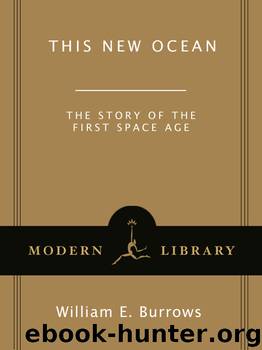This New Ocean by William E. Burrows

Author:William E. Burrows [Burrows, William E.]
Language: eng
Format: epub
ISBN: 978-0-307-76548-2
Publisher: Random House Publishing Group
Published: 2010-09-29T04:00:00+00:00
Moon à la Mode
If one technical decision can be said to be the single most important in the manned lunar program, it was the choice of mode, or exactly what route the spaceship was going to take to the Moon. On that decision rested the design of the spacecraft, its launcher, support facilities, costs, and schedules. There were two apparent possibilities, at least at the outset, which had been hotly debated at least since 1959: direct ascent and Earth orbit rendezvous.
Direct ascent involved a straight shot from Earth, more or less leading the Moon as a skeet shooter leads a clay pigeon and firing so that both objects—rocket and Moon—would arrive at the same place at the same time. This had the benefit of being relatively simple. The problem was that getting almost five thousand metric tons of rocket, spacecraft, and men off the ground and headed into orbit before only part of it—a spacecraft containing the crew, landing equipment, and fuel to get down to the lunar surface, back up again, and return home—was “injected” into a lunar trajectory would involve a staggering propulsion requirement. The answer, at least from 1959 to 1964, seemed to be the development of a colossal rocket called Nova. But the “super booster,” whose first stage alone would have to have ten powerful engines, would be both very costly and difficult to develop.
One direct ascent method, briefly raised in 1961, would in fact not have required a super booster at all because it involved a one-way trip.67 The idea, first proposed by E. J. Daniels of Lockheed Aircraft and then by two Bell Aerosystems engineers, was to deliberately strand one astronaut on the Moon (the way poor Joe had been left there in Destination Moon in 1951). The space-age Robinson Crusoe would be resupplied by rockets for years, during which time he would perform “valuable scientific experiments” while people back home tried to come up with a way to retrieve him. The Bell engineers, John N. Cord and Leonard M. Seale, acknowledged that the mission would be very hazardous, but they explained in a paper they presented in Los Angeles in June 1962 that it seemed to be the only way to beat the Russians to the Moon. NASA mission planners took the idea for what it was: lunacy.*
The other serious possibility was Earth orbit rendezvous, or EOR.68 That would have involved separately sending up the spacecraft, its equipment module, a lunar lander, and whatever else was needed for the journey into Earth orbit, forming them up like a high-tech mule train, and then heading to the Moon. The advantage was that orbiting the components separately would require far less energy for each launch than the amount needed for direct ascent. The problem, at least in the eyes of many engineers, was that EOR was impractical, complicated, and therefore very dangerous.
In the end it would be a third mode, lunar orbit rendezvous, or LOR, that was selected. This mission profile was first suggested by
Download
This site does not store any files on its server. We only index and link to content provided by other sites. Please contact the content providers to delete copyright contents if any and email us, we'll remove relevant links or contents immediately.
| Automotive | Engineering |
| Transportation |
Whiskies Galore by Ian Buxton(41935)
Introduction to Aircraft Design (Cambridge Aerospace Series) by John P. Fielding(33085)
Small Unmanned Fixed-wing Aircraft Design by Andrew J. Keane Andras Sobester James P. Scanlan & András Sóbester & James P. Scanlan(32763)
Craft Beer for the Homebrewer by Michael Agnew(18193)
Turbulence by E. J. Noyes(7977)
The Complete Stick Figure Physics Tutorials by Allen Sarah(7334)
Kaplan MCAT General Chemistry Review by Kaplan(6896)
The Thirst by Nesbo Jo(6876)
Bad Blood by John Carreyrou(6580)
Modelling of Convective Heat and Mass Transfer in Rotating Flows by Igor V. Shevchuk(6406)
Learning SQL by Alan Beaulieu(6235)
Weapons of Math Destruction by Cathy O'Neil(6205)
Man-made Catastrophes and Risk Information Concealment by Dmitry Chernov & Didier Sornette(5951)
Digital Minimalism by Cal Newport;(5698)
Life 3.0: Being Human in the Age of Artificial Intelligence by Tegmark Max(5506)
iGen by Jean M. Twenge(5384)
Secrets of Antigravity Propulsion: Tesla, UFOs, and Classified Aerospace Technology by Ph.D. Paul A. Laviolette(5330)
Design of Trajectory Optimization Approach for Space Maneuver Vehicle Skip Entry Problems by Runqi Chai & Al Savvaris & Antonios Tsourdos & Senchun Chai(5036)
Pale Blue Dot by Carl Sagan(4948)
